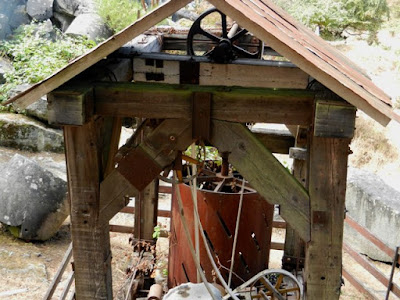 |
| Comox Harbour Authority Docks |
We departed
Discovery Harbour docks in Campbell River at 9am and had a slight push from the
current. The morning fog soon dissipated
revealing the flat, calm seas in the Strait of Georgia. As we got closer to Comox on Vancouver
Island, the direction of the current shifted, slowing our speed to 7.4 knots. The seas remained calm and we easily passed
over the Comox bar, arriving at the Harbour Authority Docks around 2pm and
settled into our slip.
 |
| Comox on Vancouver Island |
Comox is a cute
retirement town with lots of pretty flowers and shrubs that line the
streets.
Older folks are often seen
cruising down the sidewalks in their “hover-rounds.”
 |
| The Shoprider |
It seems some of these folks have moved up to
the modern mode of transportation, the “Shoprider,” an enclosed one-seat,
motorized job with four wheels which looks like a miniature car, very cute.
After the morning rain shower passed, we
walked into town, stopping at the local museum which also serves as an art
gallery.
Beautiful watercolor paintings
by local artists were on display and available for purchase.
The museum section, although small, is a nice
resource for local and Provincial history, including notable
people from the past who helped shape British Columbia.
These names are familiar to boaters,
names like Douglas and Seymour which have been used to designate islands and
various waterways.
James Douglas, born in
1803, is often called the Father of British Columbia.
After he completed his schooling in Scotland,
he moved to Canada at the age of sixteen.
 |
| Sir James Douglas |
James apprenticed with the Northwest Co. which eventually merged with
the Hudson’s Bay Company.
He was later
stationed at Fort Vancouver, Washington where he became the HBC Chief Factor in
1839.
When it became apparent that
everything below the 49
th parallel would soon become American
territory, he moved to Vancouver Island to relocate the Hudson Bay Co. Fort and
later established the Capital of Fort Victoria.
From 1851 to 1864 James Douglas served as Governor of the Colony of
Vancouver Island and in 1858 he also became the first Governor of the Colony of
British Columbia.
The two colonies would
later merge as a Province.
While in
office Douglas developed his vision of a great highway of commerce down the
centre of the mainland colony; he achieved this project in little more than two
years.
A wagon road eighteen feet wide
and 400 miles long connected the Cariboo to the coastal settlements.
Today, his name is recognized on nautical
charts and land features including Douglas Channel, James Island, James Bay,
and Douglas Peak to mention a few.
 |
| Frederick Seymour |
Another recognizable name is Frederick Seymour, born 1820, as in Seymour
Narrows, Frederick Sound, and Mount Seymour among other sites named in his
honor.
Frederick Seymour became the
second Governor of the Colony of British Columbia in 1864 and continued
building the wagon trails to the Cariboo and also helped stop a First Nation
disturbance at Bute Inlet.
Seymour did
not at first support combining the Colony of Vancouver Island and the Colony of
British Columbia but eventually relented and the two colonies became one in
1866.
When Canada became a confederation
in 1867, there was a strong desire for the B.C. colony to join as a Provence.
Seymour had managed to improve the economy
and infrastructure of the colony, culminating with the construction of a
graving dock (dry dock) at Esquimalt Harbour near Victoria.
Towards the end of his term, Seymour made a
journey to Nass River located off of Portland Inlet to mediate a dispute
between First Nations tribes.
On the
return trip, he fell ill with dysentery and died at Bella Coola.
 |
| Stakes from Fish Traps seen along Comox Bay |
The Museum also includes information about
the thousands of stakes seen on the mudflats all along Comox Bay.
The pilings or stakes are remnants of ancient
fish traps of the K’omoks people who lived in the area long before the arrival
of the Europeans.
Many of these traps
were in the shape of a heart or chevron and could function independently or as
part of a larger interconnected system.
 |
| Designs and Fish Trap Structures |
The complexity of these systems must have required skilled experts to
design, build, and maintain the traps and other skilled workers to harvest and
manage resources.
The magnitude of the
fish harvest suggests that the Native population in the area was much larger
than previously thought.
Leonard still prefers
his mode of fishing - hold out some money and go troll along the docks.
 |
| Leonard's Idea of Fishing |
To our delight, we found a commercial fishing
boat tied-up at Comox offering fresh fish for sale, including salmon, tuna, and
smoked sockeye.
The Comox fishing boat
is one of a few in B.C. where you can buy fresh fish directly off a boat
licensed to sell to the general public.
Leonard’s
early morning fishing trip in the rain proved successful, bringing home four
nice salmon steaks.























































